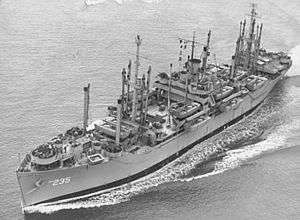USS Bottineau (APA-235)
 USS Bottineau (APA-235) underway, date and place unknown | |
| History | |
|---|---|
| Name: | USS Bottineau (APA-235) |
| Namesake: | Bottineau County, North Dakota |
| Builder: | Kaiser Shipbuilding |
| Laid down: | 11 October 1944 |
| Launched: | 22 November 1944 |
| Sponsored by: | Mrs Paul Durand |
| Acquired: | 30 December 1944 |
| Commissioned: | 30 December 1944 |
| Decommissioned: | 31 August 1955 |
| Reclassified: | LPA-235, 1 January 1969 |
| Struck: | 1 July 1961 |
| Honours and awards: | One battle star for World War II |
| Fate: | Disposed of between July '83 and January '84; probably sold for scrap |
| General characteristics | |
| Class and type: | Haskell-class attack transport |
| Tonnage: | 150,000 cu. ft, 2,900 tons |
| Displacement: | 6,720 tons (lt), 14,837 t. (fl) |
| Length: | 455 ft |
| Beam: | 62 ft |
| Draft: | 24 ft |
| Propulsion: | 1 x Joshua Hendy geared turbine, 2 x Babcock & Wilcox header-type boilers, 1 x propeller, designed shaft horsepower 8,500 |
| Speed: | 17.5 knots |
| Boats & landing craft carried: | 2 x LCM, 12 x LCVP, 3 x LCPU |
| Capacity: | 86 Officers 1,475 Enlisted |
| Crew: | 56 Officers, 480 enlisted |
| Armament: | 1 x 5"/38 caliber dual-purpose gun mount, 1 x quad 40mm gun mount, 4 x twin 40mm gun mounts, 10 x single 20mm gun mounts |
| Notes: | MCV Hull No. 681, hull type VC2-S-AP5 |
USS Bottineau (APA-235) was a Haskell-class attack transport that saw service with the US Navy in World War II.
Bottineau was named after Bottineau County, North Dakota. She was launched on 22 November 1944 by Kaiser Shipbuilding of Vancouver, Washington, under a Maritime Commission contract; transferred to the Navy 30 December, and commissioned the same day, Captain H. B. Edgar in command.
Operational history
Reporting to the Pacific Fleet, Bottineau carried a cargo of ammunition to Pearl Harbor during March 1945. Departing Pearl Harbor 9 April she carried replacement troops to Saipan, Marianas Islands, and evacuated casualties from Okinawa before returning to the United States on 10 June 1945. She then carried replacement troops to the Philippines and returned to Pearl Harbor to prepare for the invasion of Japan.
After hostilities
Following the Japanese surrender she landed elements of the 98th Division at Wakayama, Honshū, Japan, 1 October 1945. Bottineau departed 6 October for Guam and returned to the United States with Pacific veterans, arriving at Seattle, Washington, 26 January 1946.
Atomic bomb tests
Between February and May 1946 Bottineau operated between San Francisco and San Diego. Departing San Pedro, California, 25 May 1946, she arrived at Bikini Atoll 6 June for Operation Crossroads, designed to test the effectiveness of atomic bombs on warships. Over 200 warships participated in the operation, 75 of them as targets.
Bottineau's role in the tests was to act as a transport for the target vessel boarding teams. Following the tests she returned to San Francisco, arriving 21 August. She was placed out of commission in reserve there 8 March 1947.
Second commission
Recommissioned 24 March 1951, Bottineau served with Amphibious Forces, Pacific Fleet, until August when she steamed to Norfolk, Virginia, arriving 4 September. Bottineau served with the Atlantic Fleet, taking part in amphibious training exercises and other routine peacetime duties, until going out of commission at Philadelphia 31 August 1955.
She was struck from the Naval Vessel Register on 1 July 1961 and returned to the Maritime Administration, who transferred her to the National Defense Reserve Fleet, James River, Fort Eustis, Virginia. On 1 January 1969, while still in the Reserve Fleet, she was redesignated an amphibious transport, LPA-235. She was disposed of between July 1983 and January 1984, probably being sold for scrap.
Decorations
For her World War II service Bottineau received one battle star.
References
- Bottineau (APA-235), DANFS Online
- APA/LPA-235 Bottineau, Navsource Online
This article incorporates text from the public domain Dictionary of American Naval Fighting Ships.
.